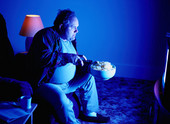- Skip Storing This Everyday Product in the Fridge Door
- Green Tea + B3 Pairing May Boost Brain Health
- Navigating Your Midlife Crisis: Embracing New Possibilities
- City Raccoons Showing Signs of Domestication
- Mapping the Exposome: Science Broadens Focus to Environmental Disease Triggers
- One Week Less on Social Media Linked to Better Mental Health
- Your Brain Changes in Stages as You Age, Study Finds
- Some Suicide Victims Show No Typical Warning Signs, Study Finds
- ByHeart Formula Faces Lawsuits After Babies Sickened With Botulism
- Switch to Vegan Diet Could Cut Your Greenhouse Gas Emissions in Half
Sitting Around in Middle Age Doesn’t Bode Well for Old Age


Your lifestyle at midlife helps predict how active you’ll be in old age, a new study says.
Researchers asked 565 adults in Iceland, at an average age of 49, about their lifestyle and other factors. Thirty years later, then 80 on average, their physical activity levels were assessed.
Having a lower level of education, poorer housing, and not being married in midlife were associated with an average of 12, 13 and 15 more minutes of inactivity a day in old age.
Being obese and having heart disease in midlife were associated with an average of 22 and 39 more minutes of inactivity a day in old age.
“Studies suggest that even when you exercise regularly, prolonged periods of sedentary time are a risk factor for cardiovascular disease, type 2 diabetes and even mortality. What is not well understood yet is what factors influence the amount of sedentary time,” said the authors of the study.
The results — recently published in Medicine & Science in Sports & Exercise — indicate that risk factors for a sedentary lifestyle in old age can be identified years before, the researchers noted.
“Given the large number of highly sedentary adults and the related risks for health, it is important to develop prevention programs that aim to reduce sedentary time,” the study authors said.
“Our findings, therefore, provide essential information for developing effective prevention strategies to reduce sedentary time and its related adverse health effects,” the researchers concluded.
More information
The U.S. National Library of Medicine has more about seniors and exercise.
Source: HealthDay
Copyright © 2025 HealthDay. All rights reserved.










